Bee Presentations
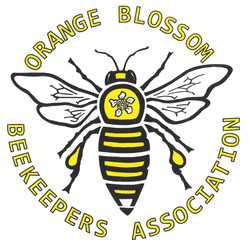
:
Swarm Control Management
General Notes
- Assume all colonies of honey bees are likely to swarm
- Regular inspections will give you the opportunities to check for swarming indicators
- Swarm prevention measures should be part of any management system
Swarm Triggers
- Overcrowding
- Overheating
- Reduced brood area
- Reduced honey storage room
- Reduced comb building
- Aging Queen
- Reduced Queen Pheromone
- Diluted Pheremone
Signs a colony is preparing to swarm
- Queen cell cups present containing eggs/larvae/food
- Colony strong at egg laying peak
- Drones present
Types of Queen Cells
| Supersedure | Swarming |
|---|---|
| 1 – 6 queen cells | 4 – 20 queen cells |
| Same development stage | Different stages |
| Occurs anytime | Seasonal |
| Cells built lower center of comb | Cells built near bottom of comb |
| Colony often weak | Colony populous |
| Worker cells contain eggs. | Eggs absent |
Swarm Queen Cell
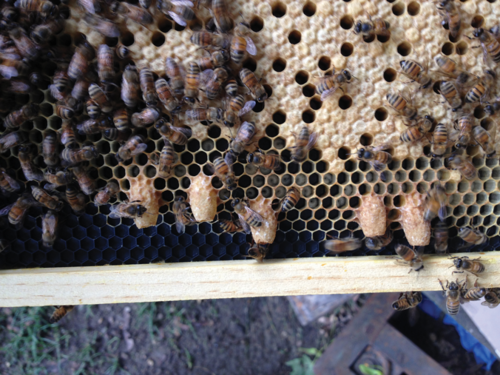
Supercedure Queen Cell
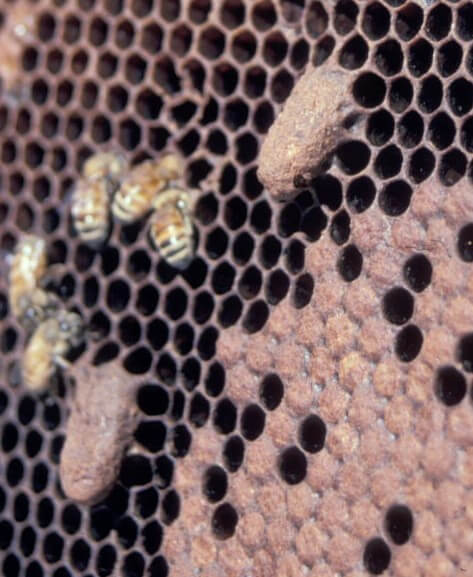
Emergency Queen Cell
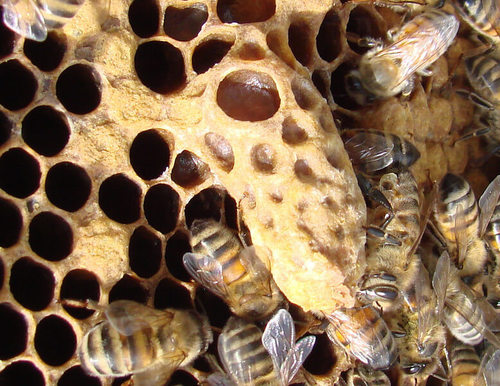
Swarm Rules
- Dry queen cups (nothing in them)
- Can be left
- Charged queen cups containing brood food
- Initiate swarm control procedures
- Sealed queen cells
- Too late – the swarm has emerged
Swarm Prevention Methods
Separate 1 from the other 2:
- Queen
- Flying bees (foragers)
- Brood
Simplest method - Collect the Swarm
An old beekeeper had an armchair in his apiary, where he sat to watch his bees during the summer months.
If a swarm issued, he collected the swarm and returned to his chair.
Swarm control but not prevention!
When queen cells are found
- No queen/swarm gone:
- Leave an unsealed queen cell or divide into nuc
- Queen present/colony not swarmed:
- Make a split (artificial swarm)
Breaking down queen cells is not a method of swarm control
Ways to Deter Swarming
- Remove some bees and brood to make a nucleus
- Move some brood to another colony
- Exchange a populous colony with swarm cells with a weaker colony in the apiary
- Add a super with empty drawn comb and foundation
- Remove the supers and bees and combine with a weak colony (newspaper)
Bait boxes
- Prepare good locations for a swarm to choose if one of your hives does swarm
An Artificial Swarm Method (Pagden)
- Breakdown the hive and place the [old] hive box/floor/roof off to one side
- Place a new floor, brood box (with frames +/- drawn comb) on the original site.
- Find the queen in the [old] brood box. Move her to the [new] box with a frame of unsealed brood.
- Make sure there are no queen cells on this frame
- Replace supers and roof on [new] hive (with queen and unsealed brood)
- In the [old] colony (with eggs, brood and nurse bees), find a nice, large queen cell and leave in place in the center of the brood. Replace the crown board and roof.
- At this stage the original colony has been artificially swarmed.
- The old queen and flying bees (in the new box) have been separated from the brood and nurse bees (in the old box).
- Any flying bees from the old box, will return to the old site and rejoin the queen
- At this stage the original colony has been artificially swarmed.
- After around 6 or 7 days, relocate the [old] hive to the other side of the new [original queen containing] hive.
- Newly flying foraging bees trying to return to the old hive will drift to the new hive, thus adding to the numbers of the artificial swarm.
A word on Florida Winter
- The warm temperatures keep the bees active all year long
- The temperature fluctuations are confusing to bees
- Remember: Just because the bees are flying doesn’t mean they are producing
Overwintering in Florida
- Entrance reducers: Help with warmth and hindering robbing
- Solid bottom boards: If temperatures get very low, it adds an extra layer of protection
- Check for nectar and honey stores early: Feed if needed
- Remove queen excluders: Allow the queen can move into the super if necessary
- Watch Varroa mite levels
Catching Swarms
(Bee Cowboys)
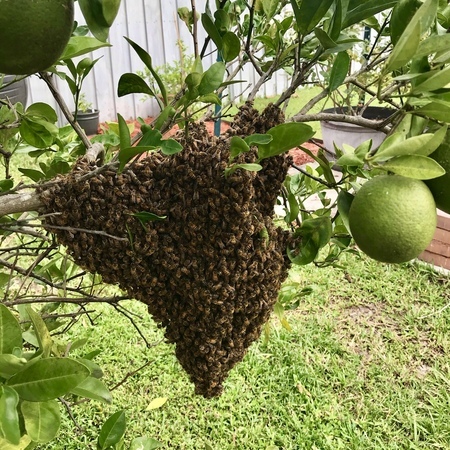
Swarms
- Blooms, Nectar, Warm temperatures
- Springtime hive growth
- Time to split
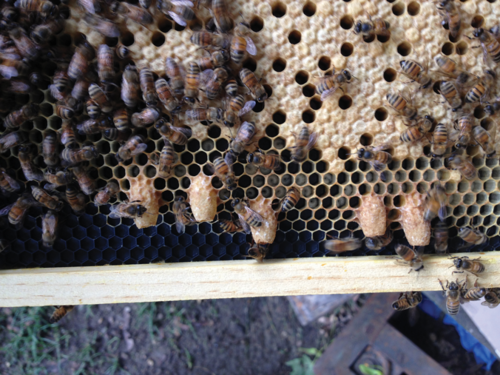
Hive growth / New Beginnings
- Queen leaves with half (50-60%) of the hive worker bees
- Nearby tree or bush for the next 24-48 hours
- Find a New Home
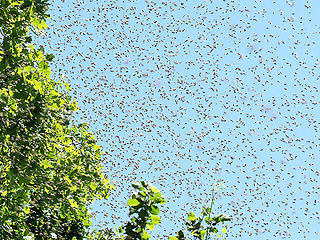
What about the hive left behind?
- New Queen will emerge
- Kill all other Queen Cups
- Mating Flight
- Begin to lay eggs after 8-12 days
Prepare to catch a swarm
- Anticipate the call:
- A container to hold the swarm
- Smoker, fuel and matches
- Strap to hold lid on container
- Bee veil
- Ladder
- Sugar syrup in a squirt bottle
Ask Questions
- Are these really honey bees?
- Ask what the "cluster looks like"
- Name, address and phone number of homeowner
- Location of swarm
- How long have the bees been there?
- How high off the ground are they?
- How big is the swarm?
- Ask permission, if needed, to snip a branch of the tree or bush holding the swarm
The Catch
- Try to place the whole cluster of bees in your container
- Can mist the hanging cluster of bees
- Can snip low branch and bees into the hive
- Carefully look for the queen
- Leave the new colony on location until night
Can you reach them?
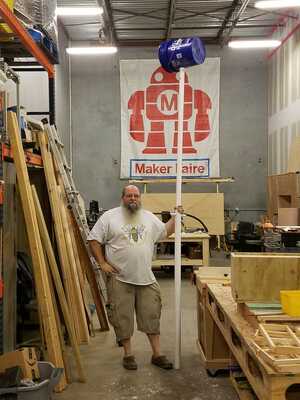
- Ladder
- Bucket/Pole
- Pool net
Swarm Traps
- Placement
- High, Low, Sunny, Shady
- Size
- Volume of a deep super
- Smell
- Old brood frames, lemongrass oil
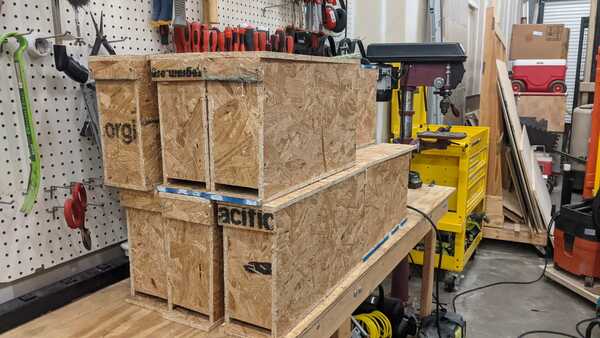
Hive your caught swarm
- Place some type of feeder on the hive
- Give them a frame with a few nurse bees and little bit of brood
- Reduce the hive entrance
- Place some obstructions in front of the hive entrance
- Plan to re-queen (Best Management Practices)
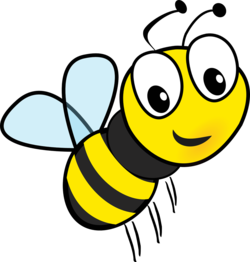
Florida Swarm Patrol (Florida Department of Agriculture and Consumer Services)
FDACS maintains a list of Registered Beekeepers and Certified Pest Control Operators who perform bee removal and/or eradication services.
Form: REQUEST FOR INCLUSION ON AHB BEE ERADICATION OR REMOVAL LIST
I request to be added to the Florida Department of Agriculture’s Bee Eradication or Removal List. I certify that I possess a Florida Pest Control Business License with a Certified Operator In Charge of the General Household and Rodent Pest Control Category (GHP-for interior or exterior bee control) and/or the Lawn & Ornamental Pest Control Category (L&O-exterior bee control only) OR I am a registered beekeeper using non-lethal methods and that I’ve received Africanized Honeybee Training (AHB).
Florida Swarm Patrol
- Beekeepers hired to remove bees are required to:
- be registered with FDACS’s Apiary Section
- but need not be licensed under Chapter 482, F.S.
- Registered beekeepers can remove and relocate nuisance swarms or established colonies in accordance with Rule 5E-14.151, Florida Administrative Code, and can apply to be on the Bee Removal or Eradication List.
The European Honeybee
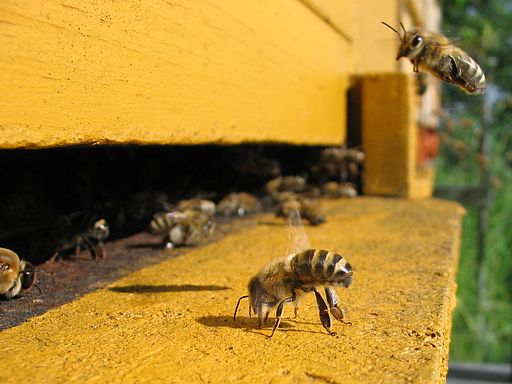
Honeybee Life Cycle
The Phases of a Bee's Life From Egg to Adulthood
- Egg
- Larvae
- Pupa
- Adult
Honeybee Castes/Classes
- Queens
- Workers
- Drones
Phase 1: Egg
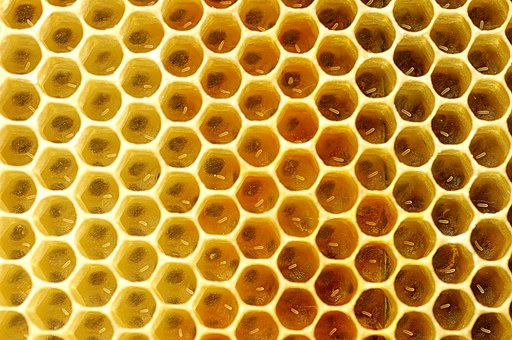
Egg laying
Queen = Hive mother (egg-laying female bees)
- Mate in flight with 7-150 drones
- Spends her life, after her mating flights, laying eggs
- Can lay 1500-2000 eggs in a day
- She decides if an egg is to be fertilized or not
- Worker (or Queen) - Fertilized
- Drone - Unfertilized
Eggs
Eggs are:
- Tiny and translucent white
- Longish and tubular (1.7 mm x 0.4 mm)
- Laid in upright position
Cell choice
Single egg in each cleaned and prepared cell
- If the cell is a standard worker-size cell (or a Queen cell) -> Fertilized egg
- If the cell is a wider, drone-size cell -> Unfertilized egg
The workers building the cells regulate the worker:drone ratio
Phase 2: Larvae
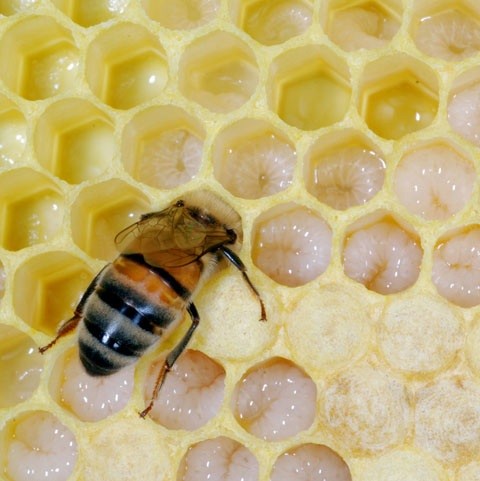
Growth
- Snowy white
- Resemble small grubs curled up in the cells
- Grow quickly - Shedding their skin 5 times
Feeding
- Workers (nurse bees) feed the Larvae
- Each Larva consume 1,300 meals a day
- Within 5 days, Larva are 1,570 times larger than their original size!
Worker or Queen?
All larvae are fed royal jelly for the first 3 days.
After those 3 days:
- Future Workers (and Drones): Diet is changed to honey/pollen mix (bee bread)
- Future Queens: Continue to receive royal jelly
Ready for the next stage
When Larva are ready, Workers seal the Larvae in the cell with a porous capping of tan beeswax
- The Larva spin a cocoon around their bodies
Phase 3: Pupa
The Metamorphosis!
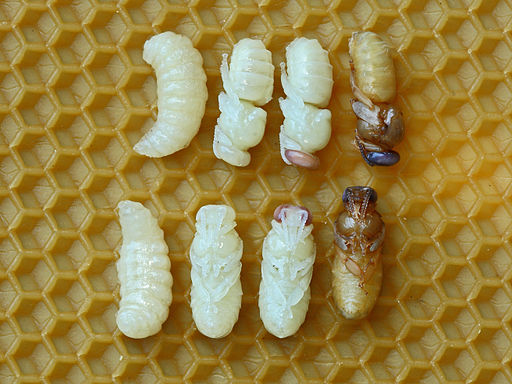
Pupal Stage
During the pupal stage:
- The bees don’t feed
- Start to look more like bees (eyes, legs, wings, etc)
- Pupal duration from shortest to longest:
- Queen < Worker < Drone
Emerging
Emerge from chamber by cutting the wax cover with their mandible

Newly emerged bees
- Wait 3-4 hours for their skin to harden before leaving hive
- They must eat to survive.
- Spend the first 2-3 weeks helping the worker bees in carrying out the routine tasks
- 3 weeks after emerging from the cocoon, they lose the glands that produce larval food and wax to become an adult bee
Phase 4: Adult

The Queen

Key for Hive Survival
The Queen is Key!
- Must lay eggs for future Workers, Drones, and Queens
- Pheromone signaling
Mating and Egg laying
- One Mating flight
- 7-150 Drones
- Can lay 1500-2000 eggs a day
- Carefully scrutinizes each egg
- Egg laying takes place in under 1 sec
Queen Pheromones
- Social glue of hive
- Gives the hive its identity and temperament
- Sends signals to workers
Aging Queen
As sperm storage depletes -> Lays fewer eggs -> Distorted egg-laying pattern
Worker bees begin nurturing next potential Queen for a new hive cycle
Queen Cells
- Swarm cells
- Placed on bottom/edge of comb
- Hive (and Queen) preparation for a swarm
- Supercedure cells
- Placed on side of comb
- Emergency if Queen loss or Replacement for aging Queen
- Never cut away unless a replacement queen is ready
Worker Bee

Worker Bee
3 tasks:
- To build hives and take care of the larvae
- To forage for food
- To defend the colony from enemies
Tasks by Worker Age
| Adult Age | Actions |
|---|---|
| 1 – 2 Days | Clean cell/Warm the brood |
| 3 – 5 Days | Feed older larvae (honey/pollen) |
| 6 – 11 Days | Feed young larvae (royal jelly) |
| 12 – 17 Days | Produce wax/Build comb/Ripen honey |
| 18 – 21 Days | Guard entrance/Hive ventilation |
| 22 + | Forage for nectar/pollen/propolis/water |
Nurse/House Bee Tasks
Days 1-17:
- Clean cells
- Keep brood warm
- Feed larvae
- Receive nectar from forager bees
- Clean hive
- Build wax comb
- Begin to take orientation flights
Guard Bee Tasks
Days 18-21:
- Keep unwanted visitors out of hive
- Fan to cool hive
- Fan to release locator pheromone (Nasonov)
- Fan to dehydrate honey
Undertaker Bee Tasks
- Remove the dead
Forager Bee Tasks
Days past 22:
- Last stage of life
- Gathers nectar and pollen
- Low survival rate
- Predators
- Insecticides
- If she survives…
- Works herself to death
Laying Worker
When Hive permanently queenless:
- Ovaries of several workers begin to develop and lay unfertilized eggs
- Normally suppressed by presence of brood, the queen, and her pheromones
- Colony is doomed
- Genetics might be passed on through drones
Drones

Drones
The sole responsibility of the drones is mating with a Queen bee - Preserving hive genetics
- Workers feed Drones
- If not needed (winter, low resources, etc)
- Pushed out of hive
- After mating, leave their sex organs on the Queen and they die a few hours later
Recap of Stage Timing
| Caste | Stage | Time in stage | Time from egg laid |
|---|---|---|---|
| Worker | Egg | 3 days | 3 |
| Drone | Egg | 3 | 3 |
| Queen | Egg | 3 | 3 |
Recap of Stage Timing
| Caste | Stage | Time in stage | Time from egg laid |
|---|---|---|---|
| Worker | Larva | 6 | 9 |
| Drone | Larva | 6.5 | 9.5 |
| Queen | Larva | 5.5 | 8.5 |
Recap of Stage Timing
| Caste | Stage | Time in stage | Time from egg laid |
|---|---|---|---|
| Worker | Pupa | 12 | 21 |
| Drone | Pupa | 14.5 | 24 |
| Queen | Pupa | 7-8 | 16 |
Life Expectancy: Queen
In extreme cases: As many as 7 years
Depends on:
- Viability of the colony
- Availability of resources
- Her output and productivity
Life Expectancy: Worker
- Born Spring to late Fall (Summer):
- Effectively work themselves to death
- Typically 6 weeks
- Born end of Fall or Early Winter:
- Charged with helping Queen survive cold months
- Up to 4-5 months
Life Expectancy: Drone
- Drones die after mating
- If they don't mate, they live 5-7 weeks
- Born late Summer:
- Evicted from hive
Hive Inspections
Queen, eggs, larva, and signs of pests

Required by FL
"Beekeepers must visually inspect all honey bee colonies a minimum of once a month to assure reasonable colony health including adequate food and colony strength."
Beekeeper Compliance Agreement - Chapter 586.10 (1), F.S. / Rule 5B-54.0105, F.A.C.
How often?
"as often as necessary, but as seldom as possible"
- At least monthly (FL)
- More frequently if:
- New install
- Swarm season
- Less experienced beekeeper
- Not too often
- Stress on the hive
- Can become aggressive
- Might abscond
What is your purpose?
- The purpose of this inspection is …
- to see if the queen is laying
- to evaluate honey stores
- to look for signs of swarming
- to look for brood disease
Outside Inspection
- Are the bees coming and going regularly?
- Do you see any foragers returning to the hive with pollen on their back legs?
- Guard bees inspecting or fighting?
- Signs of robbing?
- Ants or other threats in the area?
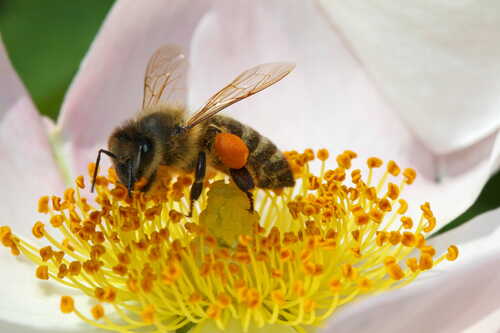
Opening the hive
- Best time to open:
- Late morning or Early afternoon
- Only open if temp is >60 F
- Use a small puff of smoke under lid
- Gently remove lid and inner cover

Space
- How many frames in each box are full?
- How many frames are covered in bees?
- "Seams of bees"
- Once about 70% of the frames are full => give the hive more space
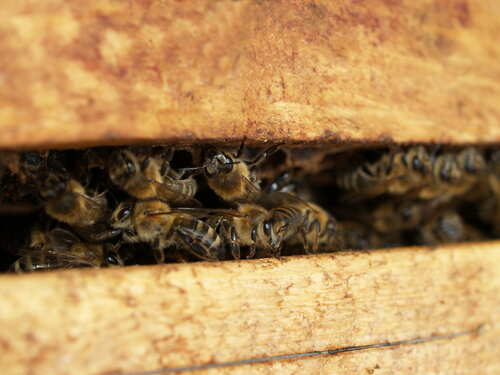
Queen Status
- Do you see your queen?
- Are there eggs (<3d)?
- Queen cells present?

Brood
- Eggs, Larvae, Capped brood
- 1 egg/larvae per cell?
- Pattern
- Brood of same age close together
- Good: Solid
- Brood of all stages with few empty cells
- Mediocre: Slightly spotty
- Poor: Spotty
- Drone brood

Nutrition
- Feed necessary or given?
- Nectar flow?
- Honey and pollen status
- Ready to harvest?

Pests or Disease?
- Small hive beetles
- Wax moths
- Varroa mites
- Ants
- Nosema
- AFB/EFB
- Odor of the hive
- Should smell like honey and beeswax
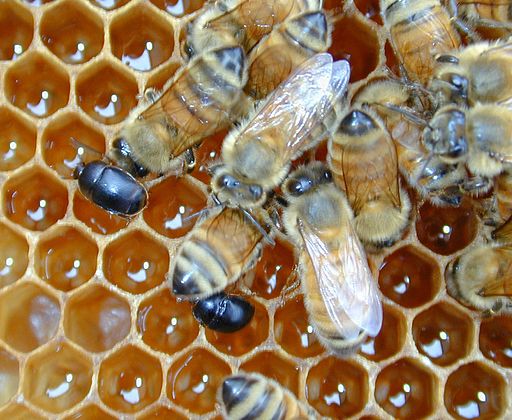
Comb
- Building good comb appropriately?
- Burr comb?
- Old comb?
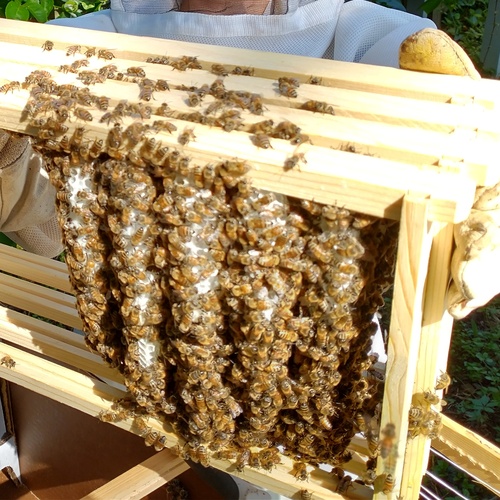
Other
- Hive temperament: Calm when you open hive?
- Population: Heavy, Moderate, Low
- Any treatments

Tips
- Have a plan
- Have a checklist
- Wear all protective gear
- Use as little smoke as you must
- Be smooth, purposeful, and brief (<15 min)
- Keep records
Here is a simple inspection checklist:
- Queen present or evidence of a queen (eggs, larva)
- All stages of brood/brood patter
- Honey and pollen in the comb
- Bees are busy working – not lethargic
- Brood (larva) is white and healthy
- No obvious sign of disease
- Few or no obvious pest problems
Records to keep
- Hive identification/Inspection date
- Does the colony have a visible queen or evidence of the queen?
- Brood Pattern – Is the queen laying a good pattern of worker brood?
- Is the colony bringing in pollen and nectar?
- Any there signs of pests or disease?
- Has the colony been tested and/or treated for mites? When? With What?
Varroa destructor Control
An Integrated Pest Management Approach
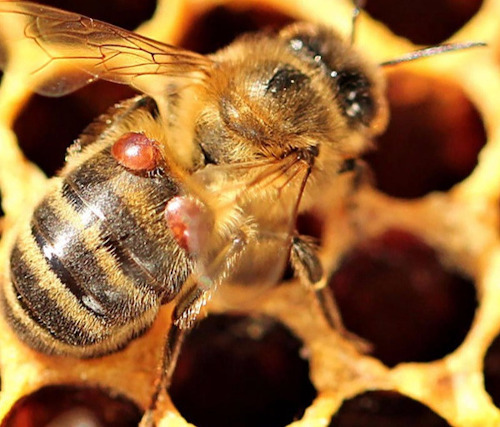
Why control Varroa?
- Can cause colony death between 6 months to two years
- Associated with 6 different honey bee viruses:
- Deformed wing virus
- Acute paralysis virus
- Sacbrood virus
- Israeli acute paralysis virus
- Kashmir bee virus
- Responsible beekeeping
- Keeping healthy honey bees can help keep healthy pollinator populations
Varroa mites
- Jumped from the Asian honey bee (Apis cerana) to the European honey bee
- Spread around the World (Arriving in USA in 1987)
- Reproduce in cells with developing workers and drones
- Feed from the fat bodies of the bees
- Controlling varroa = controlling viruses
Integrated Pest Management (IPM)
- IPM is the recommended approach
- Relies on a combination of different control methods:
- Genetic
- Cultural
- Chemical
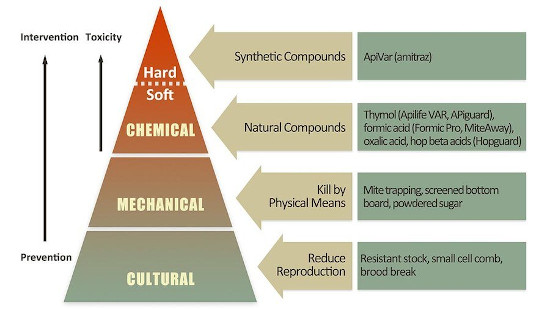
Checking mite levels
- Do this regularly
- Methods:
- Alcohol washes
- Sugar rolls
- Sticky board
- Goal: <3%
Alcohol Wash Method
- Use a wide-mouth glass jar with 50 ml (2 oz) of rubbing alcohol
- Scoop about 300 bees (1 cup) from the brood area
- NO Queen!
- Shake for several minutes
- Pour contents through a light metal wire-mesh screen
- Count number of mites (divide by 3 for a %)
Genetics
Queen selection:
- Choose new young queens
- Local survivor colony queens and Ankle biters/leg chewers queens
- Specialty queens
- Russian
- Varroa Sensitive Hygiene (VSH)
- Caucasian hybrid
- Buckfast hybrid
- Buckfast
- Improved Carniolan stock
A Test for Hygienic Behavior
- Mark a cell directly above 3 groups of 7 newly sealed cells
- Kill all 21 larva by pricking them with a pin through the cappings
- Use the same hole to prick the larva several times at different angles
- Count how many cells are completely uncapped and cleaned out after 24 hours
- Colonies which have cleaned 19 cells (90%) are considered hygienic
Cultural Methods
- Take advantage of honey bee behaviors and/or Varroa biology
- Goal: To limit the number of mites that reproduce => slowing Varroa population build up
Screened bottom boards
- Varroa fall off of bees naturally and when bees groom each other
- Allow mites to fall through (out of the hive), preventing them from crawling back up
- Passive mite control device
- Reported to reduce mite levels by as much as 40%
Sticky Boards
- Similar to screened bottom boards -> prevents mites from returning to the cluster
- After 3 days, the sticky board is removed:
- Count the Varroa
- Divide by the number of days that the board was under the hive
- If > 40 => treat the colony
Brood interruption or making splits
Interrupting the honey bee development cycle also interrupts Varroa development
- Fewer brood cells for mite reproduction
- Cage or remove the queen for approximately 3 weeks
- All of the brood hatches (mites are forced out of the cells and onto adult bees)
- Adult bees increase grooming behavior in the absence of brood
- Properly timed, can ease stress of a dearth period
Drone brood removal
- Varroa mites prefer drone brood 12x more than worker brood
- Removing capped drone brood = removing Varroa
- Cut out mostly capped Drone comb 1-3 times
- Can reduce by up to 80%
Powdered sugar dusting
- Being covered in powdered sugar causes bees to groom themselves and each other -> dislodging mites
- Labor intensive and unsure effectiveness
Chemical Control Options in Florida:
- Apiguard - essential oil from thyme plant
- Api Life VAR - essential oils from thyme, camphor, eucalyptus, mint plants
- Formic Pro (replaces Mite Away Quick Strips) - Formic acid
- HopGuard II - beta acids from hop plant
- Oxalic Acid Dihydrate
- Apivar - Amitraz, synthetic chemical, pesticide class: amidine
- Apistan - tau-fluvalinate, synthetic chemical, pesticide class: pyrethroid
Natural (Soft Chemicals)
- Apiguard (thymol)
- Spring and Fall
- Use these treatments between 60° and 105°F
- Apply in late afternoon or evening
- Don’t apply during nectar flow
Natural (Soft Chemicals)
- Api Life Var (thymol, eucalyptor, menthol, camphor)
- Spring or autumn
- Use when temperature is between 65-85°F
- Apply 3 times at 7-10 day intervals
- Remove honey supers during treatment and wait one month following treatment to harvest honey
Natural (Soft Chemicals)
- Formic Pro
- Use when temperature is between 50-92°F
- Can be used while honey supers are on
Natural (Soft Chemicals)
- Hop Guard II (hops beta acids)
- Do not use more than 3 times/year
- Can be used when honey supers are on
- More effective when less brood (does not cross cappings)
Natural (Soft Chemicals)
- Oxalic acid
- Most effective during broodless periods
- Winter or early spring method
- Should not be used as a stand-alone treatment
Synthetics (Hard Chemicals)
- Apivar (amitraz)
- Remove honey supers while treating
- Wait 2 weeks after treatment ends before replacing them
- Do not use this treatment more than 2 times/year
- Some resistance documented
Synthetics (Hard Chemicals)
- Apistan (fluvalinate)
- Remove honey supers while treating
- Do not use beeswax for human consumption after treatment
- Daytime temperatures must be at ≥50°F
- Developing resistance
Summary Chemical Table
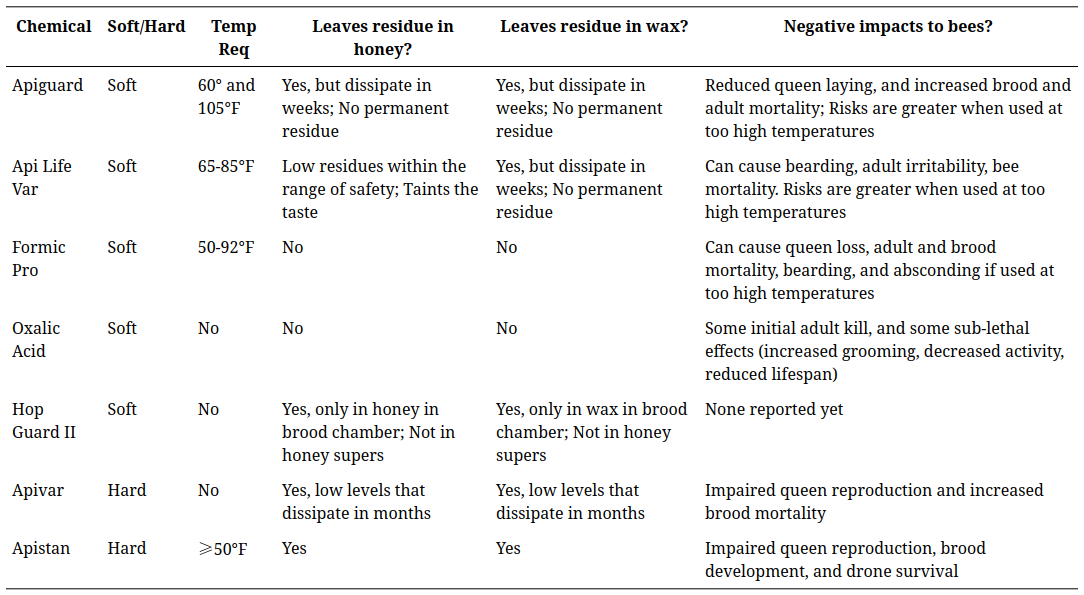
Integrated Pest Management (IPM)
- Control Varroa for healthy bees as a responsible beekeeper
- Check Varroa levels regularly
- Choose hygenic genetics
- Integrate non-chemical treatments to your strategies
- Screen bottom board, brood breaks, drone brood removal, etc
- Use chemical treatments as you must, and follow all the application directions